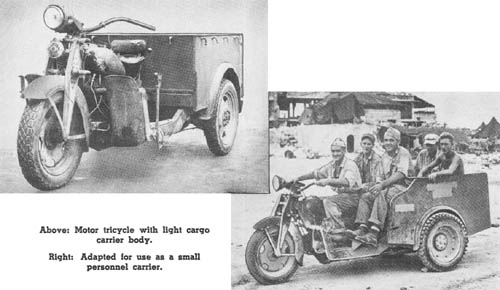
This motor tricycle has been recovered in two adaptations: as a light cargo vehicle and as a small personnel carrier. The motor is a 2-cylinder, V-type, air-cooled, gasoline engine with cooling fins made of ferrous metal. The ignition, of the automotive type, comprises battery, generator, coil, and distributor. Motorcycle type coil springing is used on the front wheels and leaf type springs on the rear part of the vehicle. The automotive type transmission provides three speeds forward and one reverse. Power is transmitted to the rear by a shaft and both rear wheels are driven through a differential. The brakes are mechanical, rod-operated, internal expanding, and operate on the two rear wheels only.
The motor tricycle has been developed as a commercial freight carrier in Japan since 1930. Many commercial versions exist, with engines ranging from 350 cc to 1,000 cc displacement. Lighter types have single-chain drive without differentials, whereas heavier types may have shaft or double-chain drive with differentials. Load capacities vary from 300 to 1,000 pounds. It is believed that the army adopted whatever types were available, and that no standard army model exists.
SPECIFICATIONS
| CARGO CARRIER | ||
| Weight | 1,185 lbs.* | |
| Loading capacity | ||
| Length (overall) | 8 ft., 11 1/2 ins. | |
| Length of body | 4 ft., 2 ins. | |
| Width (overall) | 4 ft., 1/2 in. | |
| Width of body | 3 ft., 8 1/2 ins. | |
| Height (overall) | 4 ft., 1/2 in. | |
| Ground clearance | 6 ins. | |
| Tread centers | 3 ft., 6 3/8 ins. | |
| Wheelbase | 6 ft., 3 ins. | |
| Tire size | 4.75 x 18 ins. 4.75 x 27 ins. | |
| Fuel tank | ||
| Fuel consumption | ||
| Fording depth | ||
| Speed | ||
| Engine | 2-cylinder, V-type, air-cooled, gasoline | |
| Bore and stroke | ||
| Ignition | ||
| Transmission | 3 speeds forward; 1 reverse | |
*Not verified
Japanese: p. 31 (May 1, 1945)